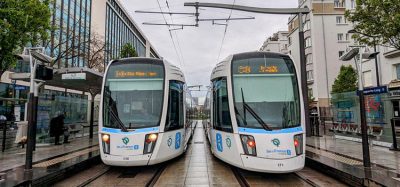Installing platform screen doors can enhance performance
- Like
- Digg
- Del
- Tumblr
- VKontakte
- Buffer
- Love This
- Odnoklassniki
- Meneame
- Blogger
- Amazon
- Yahoo Mail
- Gmail
- AOL
- Newsvine
- HackerNews
- Evernote
- MySpace
- Mail.ru
- Viadeo
- Line
- Comments
- Yummly
- SMS
- Viber
- Telegram
- Subscribe
- Skype
- Facebook Messenger
- Kakao
- LiveJournal
- Yammer
- Edgar
- Fintel
- Mix
- Instapaper
- Copy Link
Posted: 30 June 2010 | Guillaume Lecoq, Public Transport Engineer, STIF (Syndicat des transports d'Île-de-France) | No comments yet
A number of underground networks worldwide are gradually installing screen doors at the edge of their platforms to prevent passengers from falling onto the tracks. The first platform screen doors to appear in Paris were those used for the VAL line built to serve Orly airport. These were followed by those on Metro line 14; both of these lines are fully automated.
The automation currently underway on Paris Metro line 1 is the first time screen doors have been installed on an existing line. In all cases, platform screen doors are used to ensure that the system remains impervious to intrusions – a function previously incumbent on train drivers.
A number of underground networks worldwide are gradually installing screen doors at the edge of their platforms to prevent passengers from falling onto the tracks. The first platform screen doors to appear in Paris were those used for the VAL line built to serve Orly airport. These were followed by those on Metro line 14; both of these lines are fully automated. The automation currently underway on Paris Metro line 1 is the first time screen doors have been installed on an existing line. In all cases, platform screen doors are used to ensure that the system remains impervious to intrusions – a function previously incumbent on train drivers.
A number of underground networks worldwide are gradually installing screen doors at the edge of their platforms to prevent passengers from falling onto the tracks. The first platform screen doors to appear in Paris were those used for the VAL line built to serve Orly airport. These were followed by those on Metro line 14; both of these lines are fully automated.
The automation currently underway on Paris Metro line 1 is the first time screen doors have been installed on an existing line. In all cases, platform screen doors are used to ensure that the system remains impervious to intrusions – a function previously incumbent on train drivers.
Metro line 13 represents a slightly different case. Installation on this line does not form part of an automation procedure; rather, it is a response to a specific context.
Indeed, this line is one of the busiest on the Paris Metro network. On the central section, the minimum interval during peak hours is currently 95 seconds. Also at peak hours, commercial speed is 26.7km/h. Today, line 13 carries 550,000 passengers daily (2008 figures) making it the fourth-busiest line on the network, behind line 1 (725,000 passengers per day), line 4 (665,000) and line 7 (560,000).
The branch configuration of line 13 was designed at the turn of the 20th century to provide cost-effective service to developing Parisian neighbourhoods. Today, it represents one of the major difficulties for the line. Extension of these branches towards the northern suburbs in four stages (1951, 1976, 1980 and 1998) led to a rapid growth in traffic without the possibility of adjusting the transport offer as easily as on a traditional, branch-free line. This is because the extent to which it is possible to increase train frequency on the branch sections is restricted by the capacity of the central section.
The line serves three departments (Paris, Hauts-de-Seine and Seine-Saint-Denis) and 11 municipalities within a radius of 500 metres – a total of 330,000 inhabitants and 300,000 jobs. Forecasts to 2015, with regard to this data, indicate a significant growth in both population (+16,500) and jobs (+25,000), which will only add to the line’s existing problems.
Eliminating risks
Installing platform screen doors will make it possible to eliminate the risk of passengers accidentally falling onto the tracks, particularly during peak hours, and would also prevent suicide attempts. More generally, platform screen doors increase passengers’ sense of safety as they wait on platforms. At the same time, they enable better control of passenger flows and contribute to punctuality by reducing the length of stops.
The experimental phase on line 13
Given the importance of the issues of safety and punctuality, and with a view to clarifying the expected functionalities of platform screen doors systems, the STIF and the RATP decided to collaborate on an experimental phase using prototypes on line 13 in high-traffic stations.
Results of the platform screen doors experiment on line 13
In the last quarter of 2006, the RATP experimented with three platform screen doors prototypes in two stations – Saint-Lazare and Invalides. The purpose of this experiment was to demonstrate the feasibility of platform screen doors on a line operated with drivers, and to examine the performance of half-height platform screen doors (1.5-1.7m). The line 13 stations were chosen as being representative of particularly critical stations with high levels of passenger traffic.
A survey of users showed that the initiative was welcomed favourably by customers – 90% of passengers felt that securing platforms in this way offered enhanced peace of mind, while 87% were keen to see the solution deployed for the line as a whole. The behaviours observed, particularly with regard to children being left to move more freely, differed significantly from behaviours observed on non-equipped platforms. During the platform screen doors experiment, no incidents of intrusion or serious accident were reported.
The system was welcomed favourably by drivers, who did not encounter any particular difficulties and observed that it was easier to handle passenger movements in stations. The experiment showed that platform screen doors enabled drivers to have a better command of door closures and therefore of stopping time.
Aims of the project
Better control of passenger changeover
Controlling passenger changeover makes it possible to observe the correct station stopping time. Variations in station stop time are highly unfavourable in terms of operation. This is because once a train has been delayed in a station, it will have to cope with increased passenger volumes in subsequent stations, further delaying its progress and thus that of following trains.
Enhancing the safety of waiting passengers
In the busiest stations, passengers are often crowded together on congested platforms, with a risk of falls onto the tracks. In turn, this risk of falls creates apprehension on the part of drivers as they enter stations, thereby reducing the speed of the train. The resulting additional delay has direct consequences on traffic punctuality and fluidity.
Minimising incidents (suicides, falls onto the tracks) and trackside intrusions
On average, there are 2000 incidents on line 13 every year. These often require complete suspension of traffic, with particularly disruptive consequences for this busy line.
Expected results
The installation of platform screen doors makes it possible to avoid various types of incidents.
In 2005, for the line’s 30 stations, there were 166 recorded trackside intrusions – 71 of which concerned the 10 stations on the Montparnasse–Place de Clichy section. Incidents of this nature require the line’s electrical power supply to be shut down, completely halting traffic. If this shutdown lasts longer than 10 minutes, the subsection in question is isolated and partial services are implemented, requiring passengers to use other lines on the network. Electrical shutdowns may last for anything from one minute to over an hour.
In 2005, 24 falls onto the tracks were recorded on line 13 – half of them on the central section. The related power cuts lasted between one and 50 minutes.
Two serious accidents involving passengers were recorded on the central section in 2005. Serious accidents of this nature severely disrupt operation of the line for a considerable period of time, sometimes for over two hours. In such cases, partial services are implemented and trains stuck in tunnels are evacuated.
Such incidents may affect between 2,000 and 14,000 passengers, depending on the time of day.
Choice of stations
Choice of the first 10 stations on the central section
It was deemed preferable for an entire section to be equipped, firstly in order to avoid drivers having to adopt different driving behaviours from one station to the next with a possible impact on safety, and secondly in order to prevent antisocial behaviour by passengers simply being shifted to a neighbouring, nonequipped station.
The choice of the first 10 stations to be equipped was made on the basis of the stated objectives and according to the following three criteria:
- The number of passengers boarding at each station – a measure of platform congestion
- The number of passengers in the train entering the station – a major factor in controlling changeover time
- The number of recorded trackside intrusions for each station
On the basis of these criteria, the Place de Clichy–Montparnasse-Bienvenüe section was chosen. It includes 7 of the 10 busiest stations in terms of boarding passengers, 9 of the 10 busiest stations in terms of congestion, and 6 of the 9 stations with the highest number of trackside intrusions in 2005 (40% of all intrusions and two serious accidents).
Moreover, there are changeover difficulties for all the stations on this section, since there are both a large number of boarding passengers and high levels of platform congestion.
In addition, the effects of any anomaly on the central section are magnified on the branch sections. Increases in stopping time due to an inability to address such anomalies increase the time between trains and create cumulative delays. In turn, these increased intervals between trains and the accumulated delays are doubled on each branch section. Consequently, it was important to start by improving punctuality on the central section.
Lastly, for such a critical section, it was also important to be able to maintain the same driving habits from one station to the next, since any change would require drivers to consider whether or not the next station was equipped with platform barriers and thereby adjust their driving: although less significant, this was another potential source of non-punctuality of which the effects would be felt more keenly on this section compared to other stations on the line.
Choosing two other stations on branch sections
Since the time between trains is twice as long on branches, any increase in stopping time does not have the same immediate effect on the following train as it does on the central section. Consequently, the overriding criteria relates to passenger density on platforms and the resulting sense of insecurity.
Platform density is calculated by taking the number of boarding passengers and factoring in the area of the platform and the interval between trains. This analysis did not include termini, where trains remain at the platform longer and where there is no accumulation of passengers on the platforms. This analysis led to the selection of the ‘Basilique de Saint-Denis’ and ‘Saint-Denis Porte de Paris’ stations: sporting events at the Stade de France (located near this latter station) create occasional density levels comparable to those at Saint-Lazare station.
Carrying out installation work
Installing the platform screen doors
All the stations require adjustments, since this is an existing line of which the first stations date from 1910. The installation of platform screen doors required various types of engineering works, including:
- Reinforcing platform edges to bear the loads created by platform screen doors (weight, pressure from crowds, etc.)
- Work on the spandrels in some stations where shorter platform lengths did not allow platform end doors (used to evacuate trains stopped in tunnels and for access to RATP staff working on the tracks) to be installed.
Installing the platform screen doors – procedures
The plan is for the stations to be equipped continuously, going down the line. Once preparatory work on the platform has been completed, installation of the platform screen doors themselves does not require any station closures. The main platform doors can be commissioned on the same night as they are installed. A continuous section of doors may be commissioned without the entire platform screen doors being installed.
Thirty-two nights are required to install and commission 30 main platform doors plus additional platform end structures for a twoplatform station.
The order has been decided considering a number of factors: the date the first station is equipped, observing continuity along the installed selection, and the degree of difficulty of engineering works to prepare platforms. The simplest station in terms of design and construction has to be the first.
For any given platform, installation takes place at night, starting with fixed elements (complete sections starting at each end and the manual emergency control panel). Next, the 15 main platform door units and 14 emergency door units are installed, progressing from the rear of the platform towards the head. This enables the doors to be operational as soon as they are installed, even if the screen door has not been completed. There is no interruption of service or closure of the station, even for preparatory work on platforms.
Initial works began at Miromesnil Station in early 2010. Commissioning of the ‘line 13 programme’ is planned for the end of 2011.
Conclusion
Depending on the conclusions of the 12 initial stations to be equipped on line 13, equipping all stations on line 13 may be con – sidered regarding:
- Providing a definitive solution for all punctuality issues which can be addressed by means of platform screen doors
- Enhancing the sense of security for the line as a whole by completely separating the space reserved for trains from that reserved for passengers
Subsequently, gradually equipping the rest of the network one line at a time may be considered in order to enhance passenger safety. In addition, controlling passenger changeover (and therefore station stop time) and eliminating trackside intrusions would remove two threats to punctuality which are difficult to address, offering a considerable improvement in punctuality on the line, particularly at peak hours.
An estimate, carried out on a non-committal basis, subject to subsequent specific designs for each line, puts the cost of fitting out all nonequipped lines, a total of 650 platforms, at between €700 and €750 million at 2008 prices.
About the author
Guillaume Lecoq
After his Master’s degree in spatial planning, urbanism and transport studies at the Sorbonne University in Paris, Guillaume Lecoq entered the public transport authority for the Paris area (STIF) in 2006 as a Public Transport Engineer. He has been working since as a Rail Projects Manager, especially on the RER (suburban express trains) network and automatism systems.
Related topics
Infrastructure & Urban Planning
Issue
Issue 3 2010
Related organisations
STIF (Syndicat des transports d'Île-de-France)







